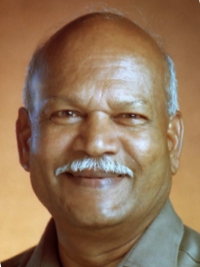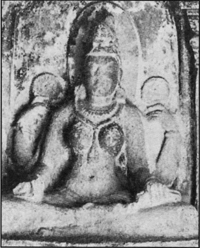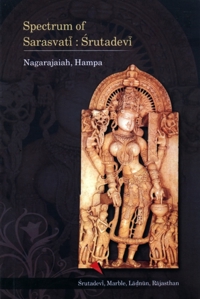|
The Mātṛkā Brahmāṇī, Brahma's consort, is indeed a form of Sarasvatī, but not referred as Sarasvatī. The Matsya Purāṇa describes Brahmāṇī as Catur-vaktrā, 'four-faced', deity, carrying sākṣasūtra-kamaṇḍaluḥ, a rosary and water-pot, with haṁsa, 'goose', as her mount - haṁsādhirūḍhā. She is depicted in cave nos. 16 and 22 at Ellorā (Maharashtra). Interestingly, in the same cave no. 16 is depicted the figures of river goddesses Gaṅgā and Yamunā standing on makara, 'alligator', and kūrma, 'tortoise', respectively. Since Sarasvatī is connected with saras, 'water', to suggest her riverine representation, she also figures as standing on lotus.
In the Jaina cave no. 32, the four-armed seated Sarasvatī (ca. tenth cent.) is depicted as holding lotuses and book.
|
|
Vāgīśvarī, a form of Sarasvatī, is sacred to and worshipped with the some intensity in both Buddhist and Jaina traditions. Vāgīśvarī form of Sarasvatī has found a prominent place in Jaina pantheon, and in the Digaṁbara sect in particular. Catherine Ludvik suggests that Vāgīśvarī, 'lady of speech', alias Vajrasarasvatī, worshipped in Buddhist tāntric, was conceptualized under the influence of eight-armed warrior Goddess cult, and Amitābha was envisaged as Vāgīśa, 'Lord of speech'. 'Sarasvatī in turn, abandoned her manuscript-bearing, vīṇā-playing form, taking on an eight-armed weapon-wielding aspect modelled on images of Mahiṣāsuramardinī, whose warrior-like appearance was clearly more suitable for our goddess in her role as defender of the Dharma' [Ludvik 269].
"We have, then, a twofold Sarasvatī: the goddess of knowledge, as Indians revere her today.... verses her battle-goddess appearance, entirely unknown to India, but a very familiar form to Japanese as the eight-armed Eloquence Talent Deity (Benzaiten)" [supra 274].
Sarasvatī is not a warrior nor a battle deity like (Durgā) Mahiṣāsuramardinī, slayer of buffalo demon Mahiṣā, who carries war weapons. In the two smaller niche like shrines, facing each other in the navaranga and flanking the sanctum of Kappe Cennigarāya temple at Belūr in Hassan Dt. (Karṇāṭaka), are enshrined with the images of Sarasvatī and Mahiṣāsuramardinī respectively.
One wonders about the justification of these two deities enshrined here. They are two poles apart, as far as their role is concerned. Warrior aspect of Sarasvatī is uncommon whereas Durgā is a battle deity. Sarasvatī is a benevolent deity of knowledge, whereas Durgā is a malevolent deity of battle.' The only Indian text in which a combative aspect of Sarasvatī emerges is the Ṛg Veda, where the powerful river goddess is invoked to conquer enemies and also compared to Indra' [Supra 199].
Four-armed seated Śrutadevī holding book in her left lower hand, Jaina cave, Ellorā, early 10th century.
Beautiful image of Sarasvatī seated in padmāsana, holds noose, goad, rosary and manuscript, wearing boxed-crown, full-moon shaped halo behind her head and an umbrella above the gem-studded crest testify to her divine status. Black stone, Kappe Cennigarāya Temple. Belūr (Karnataka), early quarter of the 12th century.
 Prof. Dr. Nagarajaiah Hampana
Prof. Dr. Nagarajaiah Hampana



